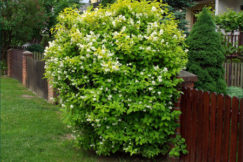Crown marshmallow - a popular shrub that is often found in park areas and attracts the attention of strolling unrivaled aroma exuded by small white flowers. In addition to fragrant inflorescences, spectacular bushes are quite undemanding and feel good with minimal care.
Material Content:
Description

Crown marshmallow, known among gardeners as garden jasmine, has the shape of a bush, the shoots of which reach a height of 3-4 m. The diameter of the crown varies depending on the age of the plant from 2 to 3 m. The smooth bark is colored brown with a reddish tint. At the end of May, the beginning of flowering is noted, which lasts about 3 weeks. White-cream flowers collected in inflorescences stand out against the background of pointed leaves of light green color.
Variety of varieties and species
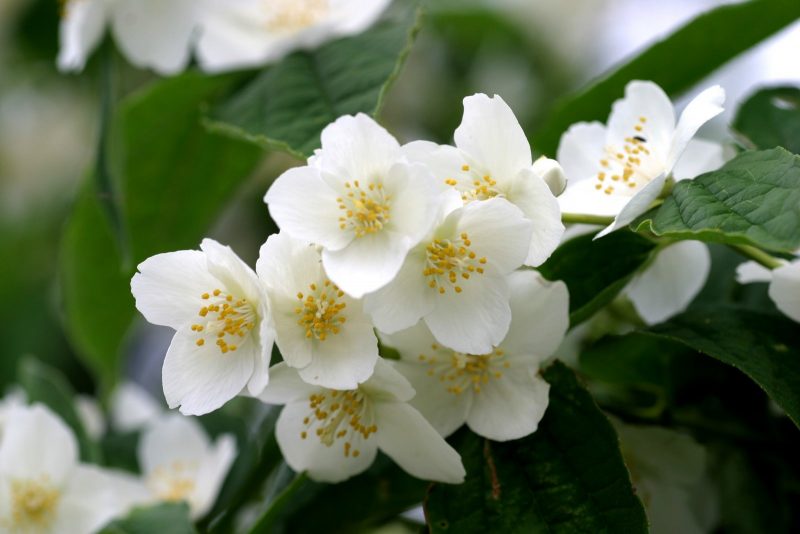
The constant work of breeders to breed new representatives of the type species has borne fruit and gave gardeners the following decorative varieties:
- Aureus - a variety with a spherical crown diameter of up to 3 m is distinguished by the color of the foliage, which changes from bright yellow in the spring to greenish yellow. Cream flowers are poorly distinguishable against the background of yellow leaf plates.
- Innocence is a compact variety whose crown is represented by variegated foliage diluted in the flowering phase with single white flowers.
- Variegatus - the variety is represented by tall bushes reaching a height of 3 m, with a white fringed stripe.
- Duplex is not a high grade, characterized by excellent winter hardiness and good rooting of cuttings.
Preparation and landing in the open ground
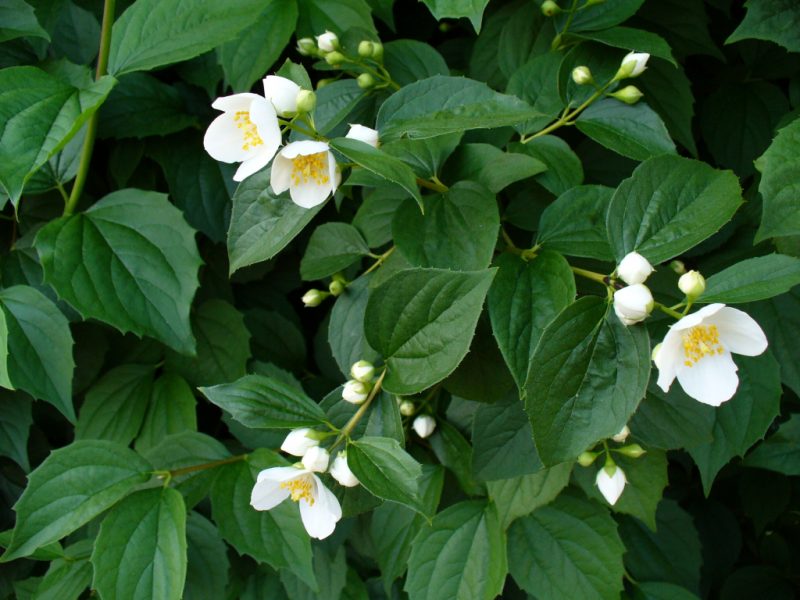
In order to enjoy abundant and prolonged flowering every year, in which the flowers exude a sweetish aroma, it is necessary to properly plant the plant, choosing the optimal place and soil.
Site selection and soil preparation
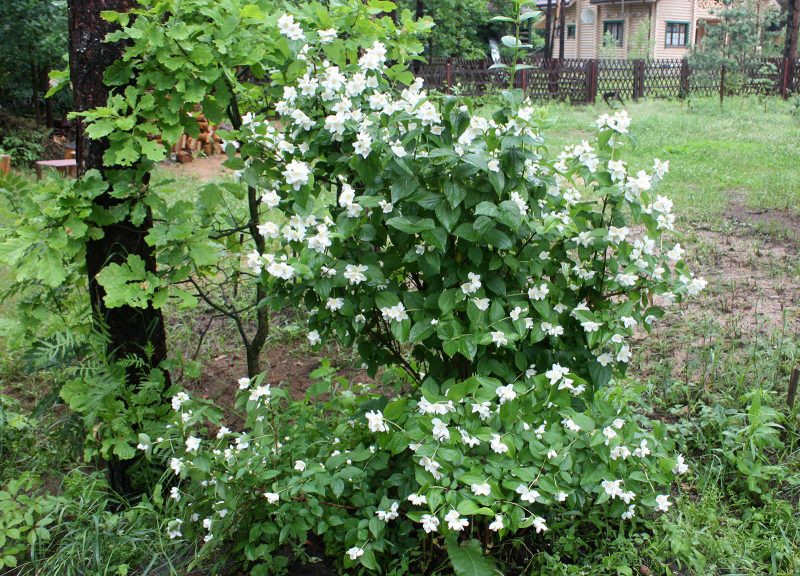
Although garden jasmine is a shade-tolerant plant, for the long-term preservation of decorativeness and ensuring abundant flowering, it is recommended to select sunny areas for the crown moss. The shrub is undemanding to the composition of soils. But if possible, it is worthwhile to prepare the soil in advance on the site and add humus, sand, ash for digging, which will improve friability and fertility.
How and when to plant
The optimal timing for landing of the coronet moth in the open ground is the first half of autumn. However, in the northern and central regions, seedlings are allowed to plant before buds open.
Landing work is carried out according to this algorithm:
- In the selected area, a landing pit is prepared with a depth of up to 50 cm.
- Drainage sinks to the bottom.
- Next, a sapling with a spread root system is lowered, which is sprinkled with extracted soil.
- The earth in the near-stem circle is crushed and watered at the rate of one copy of 20 liters of water.
Important! When laying hedges from garden jasmine, a distance between planting pits of 50-80 cm is maintained.
Crown marshmallow: cultivation and care
For the full development of the shrub, Philadelphus coronarius should be given a little time, for which he will award the gardener with an exquisite aroma.
Watering

A moisture-loving culture needs a constantly moistened soil. In the summer, 20 liters of water are poured out under an adult bush every five days. With severe drought, the procedure is carried out daily, but with a reduced volume by half. However, when wetting, it is worth remembering the measure and not allowing stagnation of moisture.
Top dressing

Shrub with fragrant flowers needs systematic top dressing:
- At the beginning of spring, manure diluted in water in a proportion of 1:10 is introduced into the near-stem circle.
- Before flowering, it is worth feeding the mock up with complex mineral fertilizers in liquid form.
- In autumn, when the plant is preparing for winter, phosphorus and potassium are necessarily included in the fertilizing.
Soil treatment
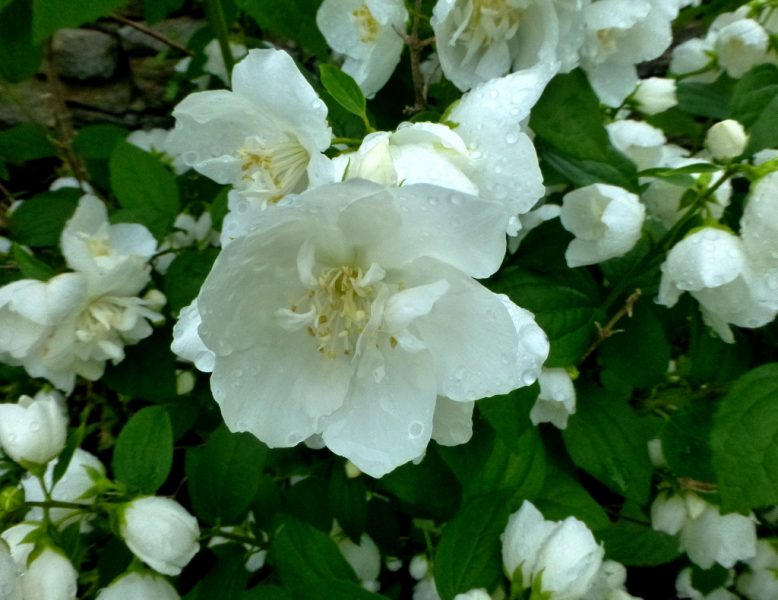
It is recommended to loosen the trunk circle after watering. But if you cover the soil under the shrub with mulch, then you will not have to water and loosen the earth so often.
Pruning
For the crown of garden jasmine to be beautiful and symmetrical, regular pruning is required. After flowering, all faded inflorescences are removed. In the spring, a sanitary haircut is carried out when damaged, growing inside shoots are cut off. Once every 2-3 years, it is recommended to shorten the skeletal branches to 30 cm, cutting out the rest to rejuvenate the bush.
Pest and Disease Control
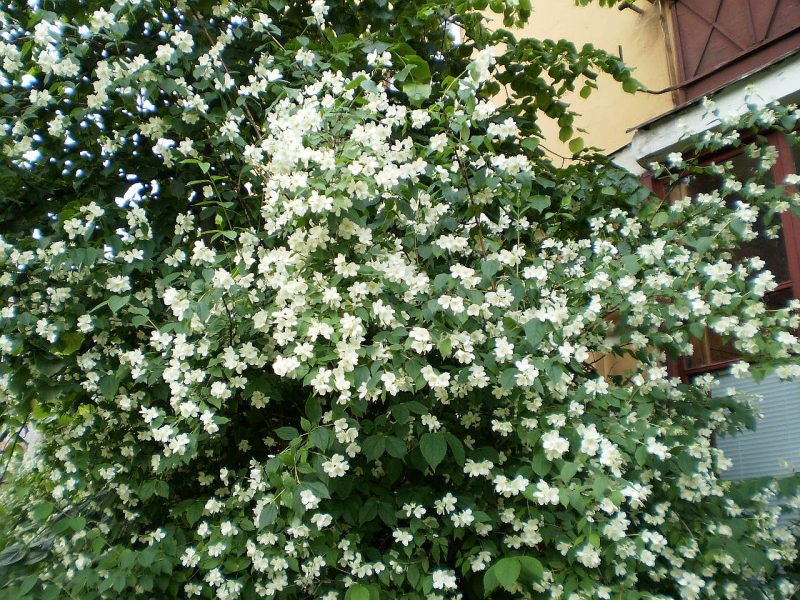
On a plant that is resistant to diseases and pests, aphids, spider mites and scale insects can sometimes be observed, which can be more effectively controlled with an insecticide. Stagnation of moisture can become the impetus for the development of a fungal infection, from which the shrub will save fungicide and the establishment of a normal irrigation regime.
Plant propagation methods
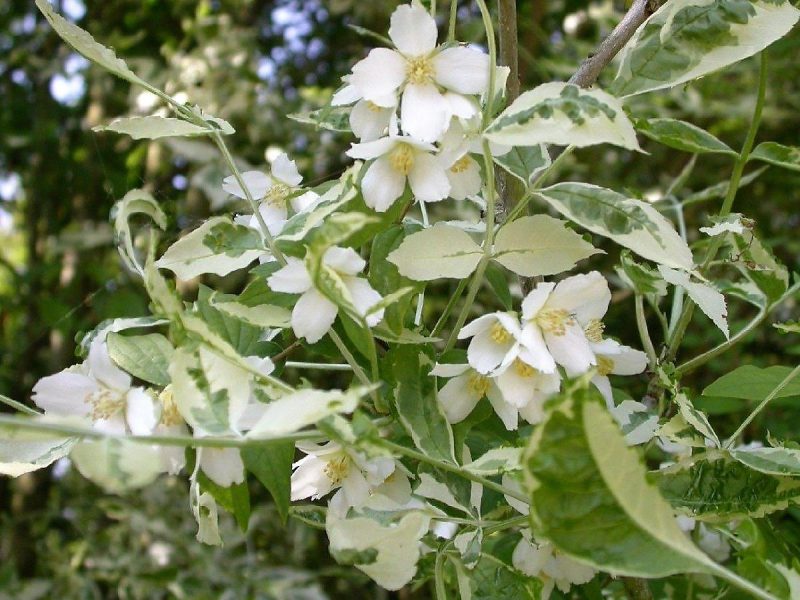
The simplest and most productive ways of propagating the crown mockwort are vegetative methods.
Cuttings
The procedure is performed in the summer when:
- Cuttings from green shoots are cut 12-15 cm long.
- Cuttings are buried in a sand-peat mixture in a slightly shaded area, where it is rooted.
- Landings are watered and mulched for the winter.
- Next fall, seedlings are planted at a permanent place of growth.
Propagation by layering

Another simple method in which a low-growing shoot is selected and dug in a pre-prepared groove.The layer is watered during the spring-summer period, and already in the fall it is separated from the mother bush and planted in the garden.
Use in landscape design
Flower mock up can be used:
- at registration of a recreation area;
- in group plantings with other flowering shrubs;
- when creating hedges;
- in the front gardens among perennial herbaceous plants of a different color palette.
Thus, the crown mockwort can be planted on a personal plot without fear that it will take away too much time and energy from the gardener for care.



